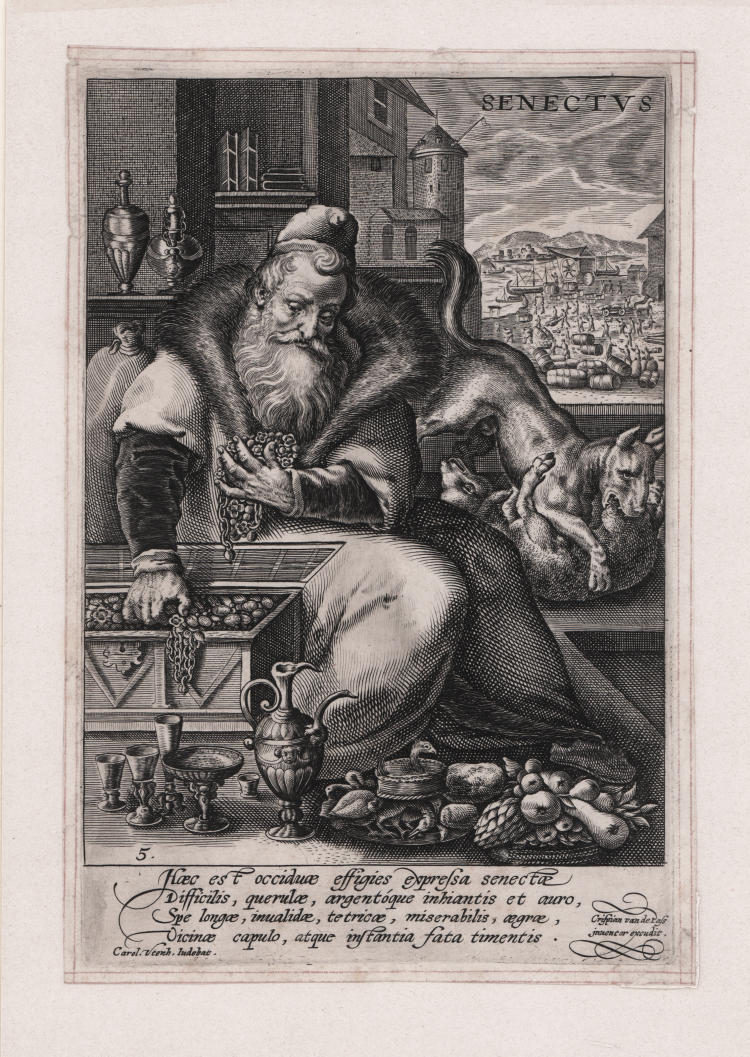




| Reference: | S27512 |
| Author | Crispijn de PASSE |
| Year: | 1599 |
| Measures: | 146 x 222 mm |



| Reference: | S27512 |
| Author | Crispijn de PASSE |
| Year: | 1599 |
| Measures: | 146 x 222 mm |
Engraving, 1599, lettered within the image in top right: "SENECTUS"; signature and address in lower margin right: "Crispian van de Pass inuentor excudit." and left "Carol. Utenh. ludebat."; in lower margin with the verse:
“Haec est occiduae expressa senectae Difficilis, querulae, argentoque inhiantis et auro, Spe longae, invalidae, tetricae, miserabilis, agrae, Vicinae capulo, atque instantia fata timentis.” by Karl Utenhoven (1500-1580).
Numbered 5 al lower left. From a set of six numbered plates and a titlepage, dedicated to the stages of human life.
The plate shows an old man, dressed in fur, with money and jewels in a chest; behind him are wolves fighting; in the background is an harbour depicted; four lines of verse below by Karl Utenhoven
Magnificent proof, printed on contemporary laid paper, with thin margins, in excellent condition.
|
Hollstein 498; Franken 1096. Dimensioni 149x220.
|
Crispijn de PASSE (Arnemuiden 1564 - Utrecht 1637)
|
Crispijn or Crispyn or Crispin or Crispianus (van) de Passe, or Pas or Passaeus (Arnemuiden, 1564 - Utrecht, March 6, 1637 (buried)), was a Dutch Golden Age engraver, painter, draughtsman and miniaturist, the progenitor of a famous family of engravers. Father of Simon, Willem, Magdalena and Crispijn and grandfather of Crispijn III, he was probably a pupil of Dirck Coornhert. He worked in Antwerp from 1580 to 1588, where, in 1585, he became a member of the local Guild of St. Luke as a master engraver. Later, because of the Spanish conquest of Antwerp and his Anabaptist faith, he worked in Aachen from 1588 to 1589; in Cologne from 1589 to 1611, where he founded his own publishing house and married Magdalena Bock for the first time; in Paris and Frankfurt am Main; and finally in Utrecht from 1611 to 1637. In this city, having obtained citizenship in 1613, he continued to work successfully as a publisher and engraver, collaborating with his sons and Aernout van Buchel. In 1636 he remarried his widow Sebastiaengen Herdrikdr. van Asch. His sons also extended the business abroad: to Paris, London (in cooperation with bookseller and publisher Hans Woutneel and Copenhagen. Crispijn's death was followed a few years later by that of his sons with the exception of the oldest (Crispijn II), who, having moved to Amsterdam, continued the family business, albeit with less success.
Crispijn mainly produced portraits for European nobility, in the manner of Jan or Hieronymus Wierix, but also prints of religious, mythological and allegorical subjects and books. By his style he can be considered to belong to the Haarlem Mannerist school. He was influenced by Sten Adamsen. He used to use the monograms CVP and PCV, also with interlaced letters, to sign his works. His pupils were his children Willem, Magdalena and Crispijn, Johann Gelle, Peter Isselburg, and probably also Cornelis Bloemaert II.
|
|
Hollstein 498; Franken 1096. Dimensioni 149x220.
|
Crispijn de PASSE (Arnemuiden 1564 - Utrecht 1637)
|
Crispijn or Crispyn or Crispin or Crispianus (van) de Passe, or Pas or Passaeus (Arnemuiden, 1564 - Utrecht, March 6, 1637 (buried)), was a Dutch Golden Age engraver, painter, draughtsman and miniaturist, the progenitor of a famous family of engravers. Father of Simon, Willem, Magdalena and Crispijn and grandfather of Crispijn III, he was probably a pupil of Dirck Coornhert. He worked in Antwerp from 1580 to 1588, where, in 1585, he became a member of the local Guild of St. Luke as a master engraver. Later, because of the Spanish conquest of Antwerp and his Anabaptist faith, he worked in Aachen from 1588 to 1589; in Cologne from 1589 to 1611, where he founded his own publishing house and married Magdalena Bock for the first time; in Paris and Frankfurt am Main; and finally in Utrecht from 1611 to 1637. In this city, having obtained citizenship in 1613, he continued to work successfully as a publisher and engraver, collaborating with his sons and Aernout van Buchel. In 1636 he remarried his widow Sebastiaengen Herdrikdr. van Asch. His sons also extended the business abroad: to Paris, London (in cooperation with bookseller and publisher Hans Woutneel and Copenhagen. Crispijn's death was followed a few years later by that of his sons with the exception of the oldest (Crispijn II), who, having moved to Amsterdam, continued the family business, albeit with less success.
Crispijn mainly produced portraits for European nobility, in the manner of Jan or Hieronymus Wierix, but also prints of religious, mythological and allegorical subjects and books. By his style he can be considered to belong to the Haarlem Mannerist school. He was influenced by Sten Adamsen. He used to use the monograms CVP and PCV, also with interlaced letters, to sign his works. His pupils were his children Willem, Magdalena and Crispijn, Johann Gelle, Peter Isselburg, and probably also Cornelis Bloemaert II.
|